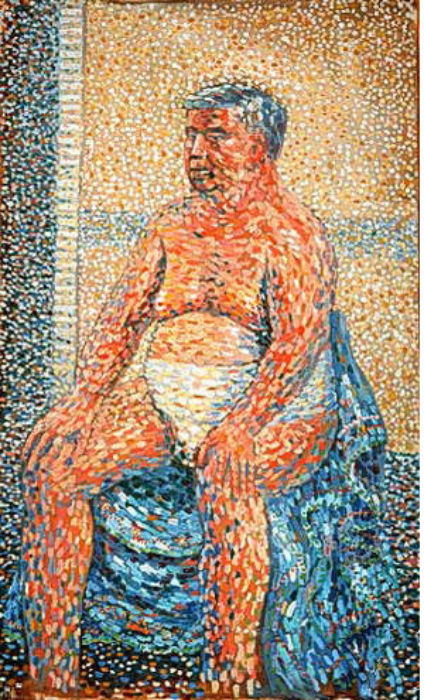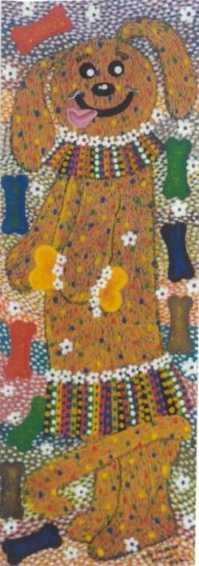

Sunday on the Pot With George
Many museum visitors were hypnotized by the image of a portly man wearing "Y-front" underwear while sitting on a big blue chamber pot. The subject of this painting has been identified as John Ashcroft, former United States Attorney General.
A visitor was so moved by George he felt compelled to express his gratitude, writing: "Someone had slipped into the bathroom as I took in this painting and began peeing loudly into a toilet (the painting was exhibited near a WC in the Dedham Community Theatre basement). The reverberating sound of urine splashing while viewing George brought the painting to life, and when the denouement of the flush sounded, I wept."
Confession of the museum founder
The museum also has its own official website, which can be visited by those curious who do not plan to go to Boston for a real visit to the amazing museum. There you can see the strangest pictures of the world — from amazing portraits to strange landscapes, where nature appears in the most incredible colour and paint combinations. Be sure to visit the Blue People (you will admire the unique characters there. All of them are distinguished by a blue skin colour; apparently when creating the paintings, the authors thought about aliens) or Landscapes section (where the most incredible landscapes are presented, apparently also alien).
Lucy in the Field with Flowers
This was the name of the masterpiece discovered by Wilson. This picture became the subject of heated discussions among visitors. Although in the museum of bad art, nevertheless the painting became famous, it always drew attention of the media and patrons of the arts.The central figure of the painting, Lucy, is described as an elderly woman dancing in the spring field among grass and flowers. Her sagging breasts flap freely, and she inexplicably holds a red chair in one hand and a bunch of daisies in the other. All this action takes place under the sky of a poisonous yellow colour. Another critic described her less floridly: "the old woman with an armchair glued to her ass".
Soon the owner of the painting were found — the very one who threw the "masterpiece" into the trash. Boston nurse Susan Lawlor recognized her grandmother, Anna Lally Keene, in the portrait. This picture hung in her aunt’s house for many years, and Susan admitted that the picture terrified her all the time: "The face in the portrait is definitely hers, but everything else is just awful. It seems that she has only one breast, and it is not clear what’s wrong with her legs and arms, and these flowers, and this yellow sky… ". Generally speaking, the unfortunate customer suffered from her own enthusiasm. And the painter who portrayed the elderly matron in such a strange and indecent form remained unknown.
Museums and Branches
Thus, thanks to Scott Wilson’s ability, a collection of "terrible pictures" had its beginning. Now the American Museum has three branches: in Dedem, the northwestern suburb of Boston, in Somerville to the north of Boston, and in Brookline, Massachusetts. Its permanent collection consists of five hundred pieces of art that are "too bad to be ignored". The museum space is limited, therefore the audience is shown thirty to forty exhibits at a time. Off-site exhibitions are often held.
The museum was founded in 1993, and the first exhibition took place in March 1994. Having found his first painting, Scott Wilson continued to rummage through heaps of trash, looking for discarded masterpieces. He then showed them to his friends, and it was decided that the collection was worthy of being exhibited in a museum. From his apartment, the collection moved first to the basement of the Dedem Theatre, then the second gallery was founded at the Somerville Theatre. The museum immediately became extremely popular. Even when the paintings were exhibited in the private house of one of the founders of the museum, hundreds of people came to "take a look" at the "special art".
Exhibition organizers do their best to keep the audience from getting bored. Sometimes they hang pictures on trees in the forest, sometimes they present "bad" nude paintings in spas or display them near toilets and at car washes.
The museum’s income is very meagre. Musician Michael Frank, curator in chief at the Museum of Bad Art, was the one who listed Studies in Digestion on eBay auction. In the picture, four panels showed the four phases of the human digestive tract. He had put a "buy-it-now" price tag of $10,000 on it, but when the first bid came in at $24.99 the buy-it-now deal died. Ultimately, the "masterpiece" was sold for $152.53.
In 1996, the Eileen by R. Angelo Lee was stolen from the museum. And despite the fact that a reward of $36.73 was offered for the return of the painting, apparently, it was so dear to the kidnapper that it was never returned.
Global fame
However, the thefts only contributed to the advertising of the museum, which has now gained worldwide fame. It is mentioned in a huge number of publications around the world and is included in the lists of the strangest world museums. The branches of the museum are listed on many guides to unusual attractions. The idea of the Boston Museum has inspired similar exhibitions in Ohio, Seattle and Australia. Actors of the local theatre troupe wrote a one-act play for the museum, which changes depending on the exhibited "masterpieces".
Art school teachers note the undoubted benefits of the museum and bring children first to MOBA, and only then to the Museum of Fine Arts. They believe that MOBA liberates children, giving them the opportunity to laugh at the paintings, and also helps to form their opinion and their perspective on works of art. Considering the popularity of the museum, they are absolutely right.
The exhibits in the collection must have significant flaws.
The main features of a "bad picture"
— Artists cannot properly depict legs or arms, and disguise them, hiding them under long sleeves or in shoes in obviously inappropriate situations.
— Complete detachment from reality. The sky in paintings is often painted in any colour other than blue, and animals and plants are painted without the slightest resemblance to any of those existing in nature.
— Incorrect perspective.
— The artist does not know how to draw the nose. Sometimes attempts to paint the nose are made so many times that the work becomes three-dimensional due to the thickness of the paint applied.
— The use of mixed media, when glitter, feathers or hair are glued to the picture.
— If the artist knows that the picture is bad, but for some reason believes that adding a poodle or a monkey to the canvas will save the day.
The works on display at the museum are often characterized as "unintentionally hilarious", like Ed Wood’s violent films. Thus, the idea of the museum is to present "the best bad art".
Many of the works in MOBA are donated, often by the artists themselves. Others come from yard sales or thrift stores; the Trash Collectors Union in Cambridge, Massachusetts has donated works rescued from imminent demise. Museum visitors often donate works as well. Occasionally a painting may be purchased; at one time MOBA’s policy was not to spend more than $6.50 on any piece.
The Museum of Bad Art collects the most horrible pictures in the world — the ones rejected by all other museums. Sometimes such paintings were found in the trash, but there appeared enthusiasts who decided to collect such paintings.
Sunday on the Pot With George (acryl on canvas)
The author of this parody of Georges Seurat’s pointillism (when the image is applied with small coloured spots that merge into a whole picture from a distance) has remained unknown. The picture is called Sunday on the Pot With George, because it looks like a parody of Seurat’s Sunday Afternoon on the Island of La Grande Jatte painting.
One of the pronounced drawbacks of the picture is the ignorance of the legs of the depicted man. The seriousness and concentration of the almost naked man sitting on the pot make a very funny impression is.

A Juggling Dog in a Grass Skirt
This amusing painting (tempera and acrylic on canvas) was donated to the museum by Mary Newman, the author herself, a professional artist from Minneapolis. She was inspired to create the picture by a caricature of a dachshund. She dressed her dachshund in the grass skirt she saw in the magazine and added coloured bones for dogs she saw at a pet store. And only after that did the painting acquire the power of impression she wanted to achieve. The picture really turned out to be very cheerful and festive, and the main character resembles a plush dog from a toy store.
What is the reason for such a museum’s existence?
Most visitors to the museum involuntarily raise this question. The museum founders answer it as follows: "The collection of the museum is a tribute to the sincerity of the artists, their persistence in striving to achieve the ideal, despite the fact that the result is terrible paintings. This collection celebrates the recognition that every artist has the right to fail!"














